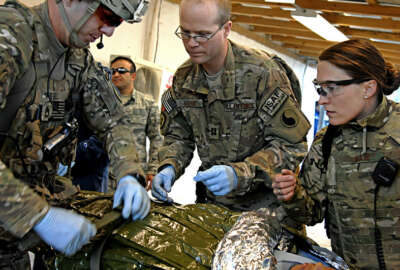
Air Force delays testing of battle management system, isolates pilots due to coronavirus
The Air Force's trial at connected weapons systems in real time will be pushed until June.
The coronavirus is throwing a wrench in the Air Force’s plan to interconnect weapons systems, and is forcing the service to change the way it treats its pilots.
Air Force Chief of Staff Gen. David Goldfein said the service will delay the testing of its Advanced Battle Management System until June.
“It’s really important that we are not canceling it, that we are postponing it, because there’s a number of industry leaders who are also involved in this,” Goldfein told reporters Wednesday at the Pentagon. “We want to make sure we get right on track as soon as the conditions allow us to.”
The test was originally set for April.
ABMS is a collection of 28 programs that follow a progression of picking up information through sensors, turning that into data, processing the data, translating it so it can be understood by multiple systems, feeding it to apps that can be used by troops and finally integrating it into warfighting capabilities.
The goal is an internet-of-things approach that will allow, for example, a drone to pick up information on an enemy and share and process that information to people in the field so they can make immediate decisions.
“We want to run the programs that will be used in ABMS through the wash cycle asking not just, ‘Are the capabilities developing and progressing, but do they work together?’” said Preston Dunlap, Air Force chief architect, in January. “We are trying to integrate the Air Force together, and then work with our partners and other services and allies around the globe to bring capabilities together.”
This test was supposed to show off the system to the Joint Chiefs of Staff. The Air Force did a previous test of the system in December, 2019, and found it the service did not stretch itself enough in with the technologies.
“26 of 28 things worked. That is too high of a success rate,” Will Roper, assistant secretary for acquisition, technology and logistics, said. “We should be taking more risk than that. We had a few issues with camera feeds we were using to show where special operations forces were. U.S. Special Operations Command also had some robot dogs that are able to patrol, but we were never able to patch their feeds in.”
“What we are doing is using the time to advance some of the technologies,” Goldfein said. “This test is significantly larger. We are going to use this time to advance those technologies so we can try even more things. If we get this right about 60% of it will work, 40% won’t work at all and we’ll learn from that and move forward.”
Pilots
The Air Force is responsible for delivering some test kits for COVID-19, a strain of the coronavirus, by working through U.S. Transportation Command.
The service is already going through a pilot shortage. Goldfein said now that pilots are in even higher demand, the Air Force is taking precautions for their safety from the virus.
Pilots are going through regular screening, temperature checks and practicing social distancing.
Read more Air Force news
“We consider the aircraft itself a clean environment,” Goldfein said. “The longer they are in that aircraft, the longer they are in an environment that is not of concern. It’s when they leave that environment to go to their rooms. We are really minimizing movement and keeping them in a bubble to make sure we can keep the force size we need to be able to maintain the missions.”
So far, seven active duty coronavirus cases are confirmed.
The military as a whole has 49 military, 14 civilian, 19 military dependent and seven contractor cases, according to Joint Staff Surgeon General Brig. Gen. Paul Friedrichs.
Copyright © 2025 Federal News Network. All rights reserved. This website is not intended for users located within the European Economic Area.
Scott Maucione is a defense reporter for Federal News Network and reports on human capital, workforce and the Defense Department at-large.
Follow @smaucioneWFED




